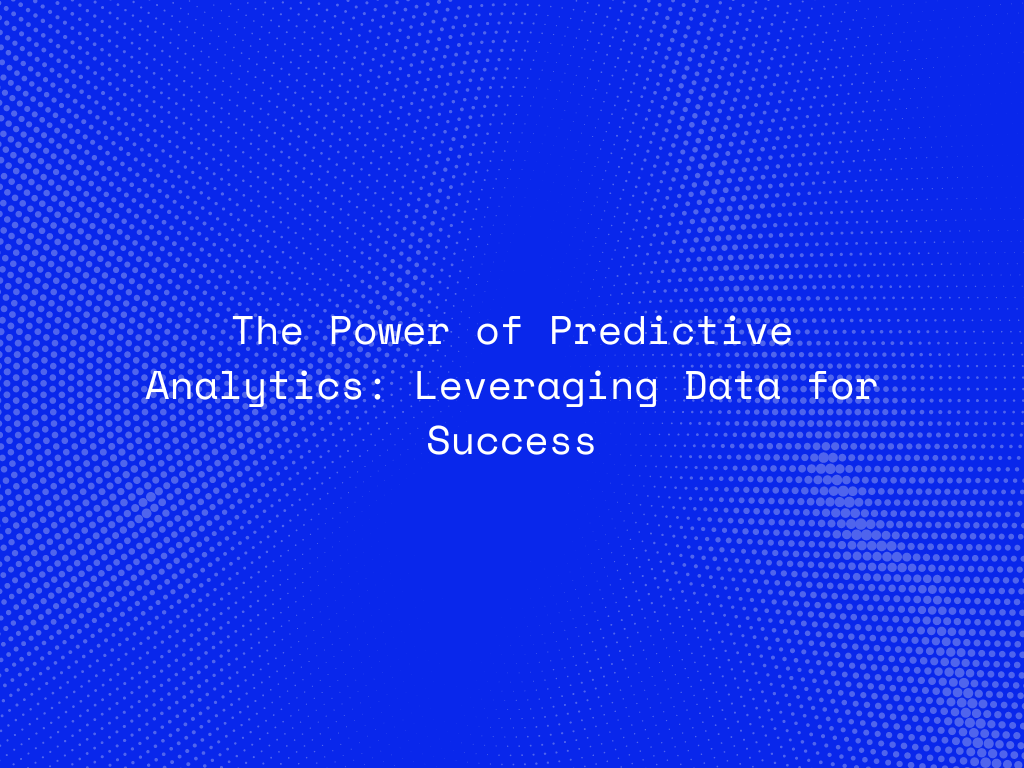In today’s data-driven world, businesses are increasingly turning to predictive analytics to gain a competitive edge. Predictive analytics uses historical data, statistical algorithms, and machine learning techniques to identify the likelihood of future outcomes based on past patterns. By leveraging this powerful tool, organizations can make informed decisions, optimize processes, and anticipate trends, ultimately driving success and growth. This blog explores the power of predictive analytics, its applications, and how businesses can harness its potential to achieve their goals.
Understanding Predictive Analytics
Predictive analytics involves analyzing current and historical data to make predictions about future events. It goes beyond simply looking at what has happened (descriptive analytics) or why it happened (diagnostic analytics) to forecast what is likely to happen next.
- Key Components:
- Data Collection: Gathering relevant data from various sources, such as transactional databases, sensors, social media, and more.
- Data Analysis: Applying statistical methods and machine learning algorithms to identify patterns and correlations in the data.
- Modeling: Creating predictive models that can be used to forecast future events or behaviors.
- Validation: Testing the accuracy of the predictive models using new or unseen data.
- Deployment: Integrating the predictive models into business processes to guide decision-making.
Applications of Predictive Analytics
-
Customer Insights and Personalization
- Customer Segmentation: Predictive analytics can segment customers based on their behavior, preferences, and demographics, allowing businesses to tailor marketing efforts to specific groups.
- Churn Prediction: By identifying patterns that indicate when a customer is likely to leave, businesses can take proactive measures to retain them, such as personalized offers or improved customer service.
-
Sales and Marketing Optimization
- Lead Scoring: Predictive models can rank leads based on their likelihood to convert, enabling sales teams to focus their efforts on high-potential prospects.
- Campaign Effectiveness: Predictive analytics can forecast the success of marketing campaigns, helping businesses allocate resources more effectively and maximize ROI.
-
Risk Management
- Fraud Detection: Predictive analytics can identify suspicious patterns in transactions, flagging potential fraud before it occurs, thereby protecting businesses and customers.
- Credit Scoring: Financial institutions use predictive models to assess the creditworthiness of applicants, reducing the risk of defaults and improving lending decisions.
-
Supply Chain Optimization
- Demand Forecasting: Predictive analytics can forecast product demand, allowing businesses to optimize inventory levels, reduce stockouts, and minimize excess inventory.
- Logistics and Route Optimization: Predictive models can identify the most efficient delivery routes and times, reducing transportation costs and improving customer satisfaction.
-
Operational Efficiency
- Predictive Maintenance: By analyzing data from machinery and equipment, predictive analytics can anticipate when maintenance is needed, reducing downtime and extending the lifespan of assets.
- Resource Allocation: Predictive models can help businesses allocate resources, such as labor and materials, more efficiently based on anticipated demand and workload.
-
Healthcare
- Patient Outcomes: Predictive analytics can be used to forecast patient outcomes, allowing healthcare providers to tailor treatment plans and improve care.
- Disease Outbreak Prediction: By analyzing patterns in healthcare data, predictive models can forecast disease outbreaks, enabling proactive public health measures.
Connect With Us
Benefits of Predictive Analytics
-
Informed Decision-Making
- Predictive analytics provides data-driven insights that empower businesses to make informed decisions, reducing reliance on intuition or guesswork.
- Businesses can anticipate challenges and opportunities, allowing for proactive rather than reactive strategies.
-
Cost Savings
- By optimizing processes such as inventory management, resource allocation, and maintenance, predictive analytics can lead to significant cost savings.
- Reducing risks, such as fraud and customer churn, helps businesses avoid potential losses.
-
Competitive Advantage
- Businesses that leverage predictive analytics can gain a competitive edge by staying ahead of market trends, anticipating customer needs, and optimizing operations.
- Personalization and targeted marketing efforts enabled by predictive analytics can lead to increased customer satisfaction and loyalty.
-
Increased Efficiency
- Predictive models streamline operations by automating decision-making processes, reducing the need for manual intervention.
- Businesses can allocate resources more effectively, improving overall efficiency and productivity.
-
Enhanced Customer Experience
- Predictive analytics allows businesses to deliver personalized experiences, anticipate customer needs, and provide timely and relevant solutions.
- By predicting and addressing potential issues before they arise, businesses can enhance customer satisfaction and build stronger relationships.
Challenges and Considerations
-
Data Quality and Integration
- The accuracy of predictive models depends on the quality and completeness of the data used. Inconsistent or incomplete data can lead to inaccurate predictions.
- Integrating data from disparate sources can be challenging, requiring robust data management and integration strategies.
-
Model Accuracy and Validation
- Predictive models must be validated and regularly updated to ensure their accuracy over time. Changes in market conditions, customer behavior, or external factors can affect model performance.
- Overfitting, where a model performs well on historical data but poorly on new data, is a common challenge that must be addressed.
-
Ethical Considerations
- The use of predictive analytics raises ethical concerns, particularly regarding data privacy and the potential for bias in predictive models.
- Businesses must ensure that their use of predictive analytics complies with data protection regulations and ethical standards.
-
Skill and Expertise
- Implementing predictive analytics requires specialized skills in data science, machine learning, and statistics. Businesses may need to invest in training or hire experts to build and maintain predictive models.
- Interpreting and acting on predictive insights also requires domain expertise to ensure that decisions align with business goals.
Connect With Us
Best Practices for Implementing Predictive Analytics
-
Start with Clear Objectives
- Define the specific business objectives you aim to achieve with predictive analytics, such as increasing sales, reducing churn, or optimizing inventory.
- Align predictive analytics initiatives with overall business strategy to ensure they deliver tangible value.
-
Invest in Quality Data
- Prioritize data quality by ensuring that your data is accurate, complete, and up-to-date. Implement data governance practices to maintain data integrity.
- Leverage a variety of data sources to enrich predictive models and improve their accuracy.
-
Choose the Right Tools and Technologies
- Select predictive analytics tools and platforms that align with your business needs and technical capabilities. Consider factors such as ease of use, scalability, and integration with existing systems.
- Explore cloud-based solutions that offer flexibility and scalability, allowing you to expand your predictive analytics capabilities as needed.
-
Collaborate Across Teams
- Involve stakeholders from different departments, such as marketing, sales, operations, and finance, to ensure that predictive analytics initiatives address cross-functional needs.
- Encourage collaboration between data scientists and domain experts to build models that accurately reflect business realities.
-
Monitor and Refine Models
- Continuously monitor the performance of predictive models and refine them as needed to maintain accuracy and relevance.
- Regularly update models to reflect changes in the business environment, customer behavior, and market conditions.
-
Ethical Use of Data
- Ensure that your use of predictive analytics adheres to ethical standards and complies with data privacy regulations. Be transparent with customers about how their data is used.
- Implement measures to detect and mitigate bias in predictive models, promoting fairness and equity in decision-making.
Conclusion
Predictive analytics is a powerful tool that can transform the way businesses operate, offering insights that drive informed decision-making, optimize processes, and enhance customer experiences. By leveraging data effectively, businesses can anticipate trends, reduce risks, and gain a competitive edge in the market. However, to fully realize the potential of predictive analytics, it is essential to invest in quality data, choose the right tools, and adopt best practices for implementation. As predictive analytics continues to evolve, businesses that embrace its power will be well-positioned to achieve long-term success in an increasingly data-driven world.




